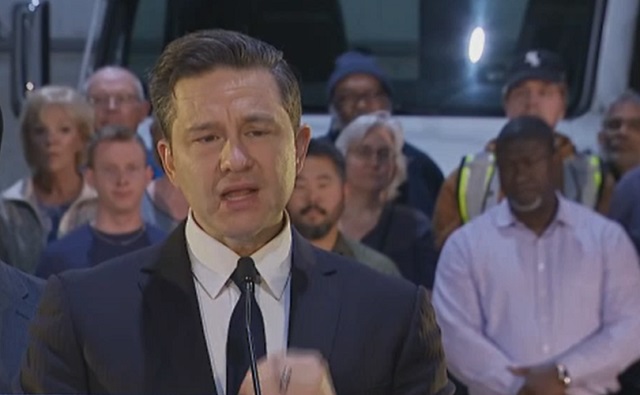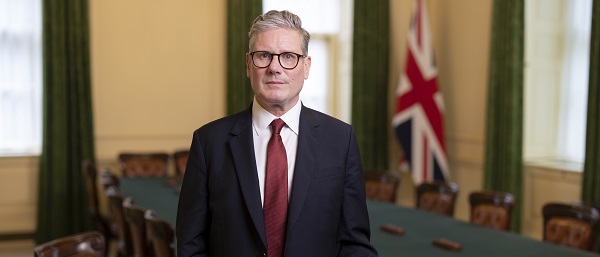Politics
Poilievre chastises Trudeau for dealing with inflation like a ‘pyromaniac promising to fight a fire’

From LifeSiteNews
At a Fix the Budget rally, the Conservative Party leader made three demands ahead of the 2024 budget release.
Conservative Party of Canada (CPC) leader Pierre Poilievre criticized Prime Minister Justin Trudeau’s pledge to combat sky-high inflation in a strong rebuke of the handling of the nation’s economy.
“Justin Trudeau promising to fight inflation is like a pyromaniac promising to fight a fire,” Poilievre said Sunday during a “Fix the Budget” rally at a truck depot in Mississauga, Ontario.
“He’s the one that lit the fire with his taxes and his deficits.”
Poilievre noted that “every day” Trudeau is seen in planned “photo ops,” saying that many Canadians “know the money that he’s spitting out of his mouth is money that will come out of your pocket, just like it has for the last eight years.”
The CPC leader said during the rally that his party has three demands for Trudeau concerning his upcoming 2024 budget, which is set to be released on April 16.
“Ax the Trudeau tax on food and farmers; two, build homes, not bureaucracies; and three, cap the spending with a dollar-for-dollar law to bring down inflation and interest rates,” Poilievre said.
Poilievre also mentioned that he wants the Trudeau government to take away the tax on food and farmers via Bill C-234, which, if passed, would take away the carbon tax on farmers, their barns, and fuel they use to dry grain.
The bill would amend the current Greenhouse Gas Pollution Pricing Act to take the carbon tax off farmers, barns, and drying, which Poilievre said will provide food price relief to Canadians.
Poilievre also said he wants the federal government to bring in a “dollar-for-dollar” law that would help to lower high interest rates, which contributes to inflation.
He also promised that the CPC, should it form the next government, will “cut back office bureaucracy, botched procurements, and foreign aid to dictators, terrorists, and multinational bureaucracies.”
“We’ll bring that money home and invest it in our military,” he said.
Poilievre also accused Trudeau’s spending, which skyrocketed during the COVID crisis, of being a leading cause of inflation.
“When you double the national debt, you drive up demand, which builds up goods. You print $600 billion of cash, and that causes inflation just like it has everywhere and always over the last 5,000 years of economic history,” he said.
The Liberal federal government has faced backlash, notably from the CPC, that high inflation and immigration have led to soaring housing prices and interest rates.
The Bank of Canada, for the sixth straight time since July 2023, held the interest rate at 5 percent.
Protests against Trudeau have been increasing in recent months due to the unpopularity of higher carbon taxes and other governmental policies.
As reported by LifeSiteNews, Trudeau’s carbon tax is costing Canadians hundreds of dollars annually, as government rebates are not enough to compensate for high fuel costs.
Franco Terrazzano, federal director of the Canadian Taxpayers Federation, told LifeSiteNews in January that “If the government wanted to make all areas of life more affordable, the government should leave more money in people’s pockets and cut taxes.”
“Trudeau should completely scrap his carbon tax,” he added.
Recent polls show that the scandal-plagued government has sent the Liberals into a nosedive with no end in sight. Per a recent LifeSiteNews report, according to polls, in a federal election held today, Conservatives under Poilievre would win a majority in the House of Commons over Trudeau’s Liberals.
Opinion
Country music star Paul Brandt asks Parliament to toughen laws against child porn

From LifeSiteNews
Paul Brandt is calling on Parliament to exercise the notwithstanding clause of the Charter of Rights and Freedoms after a teen in Calgary made deepfake child porn from photos of schoolgirls.
Canadian country music star Paul Brandt is calling on Parliament to exercise the notwithstanding clause of the Charter of Rights and Freedoms in the wake of another horrifying case of a boy creating digital deepfake pornography of female classmates—child sexual abuse material (CSAEM).
A 17-year-old boy in Calgary, Alberta used AI to transform normal photographs of schoolgirls into child sexual abuse material and then uploaded them to social media. According to police, the teen is facing charges “including making, possessing, and distributing child sexual abuse and exploitation materials, along with criminal harassment.”
“The victims—teen girls from multiple high schools—are now in trauma counselling,” wrote Brandt in an X thread that has already been viewed nearly a million times. “Some may never feel safe at school again. Their images are forever weaponized. This isn’t ‘bullying.’ This is sexual violence enabled by technology and enabled by weak laws.”
“Under the law before October 31, 2025, this boy faced a mandatory 1-year jail sentence for making & distributing CSAEM, plus another possible 1-year for possession,” Brandt continued. “That floor sent a clear message: you do not get to sexually exploit children and walk away with probation…The Supreme Court struck down the 1-year mandatory minimum for possession of CSAEM because of a hypothetical 18-year-old who keeps a consensual sext from his 17-year-old girlfriend.”
RELATED: Canada’s Supreme Court goes soft on child pornography
This ruling, Brandt noted, means that many judges will let “young offenders” off light—and the social consequences of this will be transformative. “Imagine being one of those Calgary girls and hearing the boy who deepfaked you into porn might get… house arrest,” Brandt wrote. “Or a conditional discharge. Or NOTHING. Because a court 3,000 km away worried about a different, hypothetical 18-year-old’s love life.”
These “mandatory minimums,” Brandt stated, are essential. “They are the only way to tell every teenager with a phone and an AI app: If you turn a classmate into child sexual abuse material, your life changes too. You do not get to ruin hers and live yours without consequence. Without that certainty, we are teaching two generations the wrong lesson: Victims: ‘Your trauma is negotiable.’ Perpetrators: ‘Worst-case scenario is a stern talking-to.’”
Importantly, mandatory minimum sentences for these crimes were an important deterrent to sexually predatory behavior. “After mandatory minimums were introduced in 2015, self-reported teen sextortion and revenge-porn cases dropped,” Brandt wrote.
When the floor disappears, the behaviour comes roaring back—we’re already seeing it in the 54% surge in Alberta ICE files this year. The perpetrator is also a child. He needed a bright red line years ago—before he pressed “generate.” Clear, certain punishment protects him too: from becoming an adult predator, from a lifetime on the sex-offender registry, from potentially destroying his own future along with theirs.
Brandt called on Prime Minister Mark Carney’s Liberal government to invoke the notwithstanding clause and “restore the mandatory minimums for possession, making, and distribution of CSAEM,” and table a bill “with even stronger sentence if necessary. Brandt called on Canadians to sign his petition urging the government to take action “before the next classroom is violated.”
Paul Brandt launched an anti-sex trafficking organization in 2017 called #NotInMyCity, which focuses on raising awareness, advancing preventative strategies, mobilizing communities, and “facilitating transformational systems change.” The organization has assembled a vast army of corporate, political, and social allies over the past eight years.
LSN published a report in this space on December 3, detailing the growing crisis of AI-generated pornography via apps like “nudify,” which children and teens have used to digitally undress their classmates and produce CSAEM.
RELATED: AI is accelerating the porn crisis as kids create, consume explicit deepfake images of classmates
Alberta
Premier Smith: Canadians support agreement between Alberta and Ottawa and the major economic opportunities it could unlock for the benefit of all

From Energy Now
By Premier Danielle Smith
Get the Latest Canadian Focused Energy News Delivered to You! It’s FREE: Quick Sign-Up Here
If Canada wants to lead global energy security efforts, build out sovereign AI infrastructure, increase funding to social programs and national defence and expand trade to new markets, we must unleash the full potential of our vast natural resources and embrace our role as a global energy superpower.
The Alberta-Ottawa Energy agreement is the first step in accomplishing all of these critical objectives.
Recent polling shows that a majority of Canadians are supportive of this agreement and the major economic opportunities it could unlock for the benefit of all Canadians.
As a nation we must embrace two important realities: First, global demand for oil is increasing and second, Canada needs to generate more revenue to address its fiscal challenges.
Nations around the world — including Korea, Japan, India, Taiwan and China in Asia as well as various European nations — continue to ask for Canadian energy. We are perfectly positioned to meet those needs and lead global energy security efforts.
Our heavy oil is not only abundant, it’s responsibly developed, geopolitically stable and backed by decades of proven supply.
If we want to pay down our debt, increase funding to social programs and meet our NATO defence spending commitments, then we need to generate more revenue. And the best way to do so is to leverage our vast natural resources.
At today’s prices, Alberta’s proven oil and gas reserves represent trillions in value.
It’s not just a number; it’s a generational opportunity for Alberta and Canada to secure prosperity and invest in the future of our communities. But to unlock the full potential of this resource, we need the infrastructure to match our ambition.
There is one nation-building project that stands above all others in its ability to deliver economic benefits to Canada — a new bitumen pipeline to Asian markets.
The energy agreement signed on Nov. 27 includes a clear path to the construction of a one-million-plus barrel-per-day bitumen pipeline, with Indigenous co-ownership, that can ensure our province and country are no longer dependent on just one customer to buy our most valuable resource.
Indigenous co-ownership also provide millions in revenue to communities along the route of the project to the northwest coast, contributing toward long-lasting prosperity for their people.
The agreement also recognizes that we can increase oil and gas production while reducing our emissions.
The removal of the oil and gas emissions cap will allow our energy producers to grow and thrive again and the suspension of the federal net-zero power regulations in Alberta will open to doors to major AI data-centre investment.
It also means that Alberta will be a world leader in the development and implementation of emissions-reduction infrastructure — particularly in carbon capture utilization and storage.
The agreement will see Alberta work together with our federal partners and the Pathways companies to commence and complete the world’s largest carbon capture, utilization and storage infrastructure project.
This would make Alberta heavy oil the lowest intensity barrel on the market and displace millions of barrels of heavier-emitting fuels around the globe.
We’re sending a clear message to investors across the world: Alberta and Canada are leaders, not just in oil and gas, but in the innovation and technologies that are cutting per barrel emissions even as we ramp up production.
Where we are going — and where we intend to go with more frequency — is east, west, north and south, across oceans and around the globe. We have the energy other countries need, and will continue to need, for decades to come.
However, this agreement is just the first step in this journey. There is much hard work ahead of us. Trust must be built and earned in this partnership as we move through the next steps of this process.
But it’s very encouraging that Prime Minister Mark Carney has made it clear he is willing to work with Alberta’s government to accomplish our shared goal of making Canada an energy superpower.
That is something we have not seen from a Canadian prime minister in more than a decade.
Together, in good faith, Alberta and Ottawa have taken the first step towards making Canada a global energy superpower for benefit of all Canadians.
Danielle Smith is the Premier of Alberta
-

 Energy2 days ago
Energy2 days agoA look inside the ‘floatel’ housing B.C.’s LNG workforce
-

 National2 days ago
National2 days agoAlberta will use provincial laws to stop Canadian gov’t from trying to confiscate legal firearms
-

 Energy2 days ago
Energy2 days agoELZABETH MAY HAS IT WRONG: An Alberta to Prince Rupert Oil Pipeline Will Contribute to Greater Global Oil Tanker Safety
-

 illegal immigration1 day ago
illegal immigration1 day agoWhile Trump has southern border secure, hundreds of thousands of illegal immigrants still flooding in from Canada
-

 Censorship Industrial Complex1 day ago
Censorship Industrial Complex1 day agoCanadian bishops condemn Liberal ‘hate speech’ proposal that could criminalize quoting Scripture
-

 COVID-192 days ago
COVID-192 days agoCanadian legislator introduces bill to establish ‘Freedom Convoy Recognition Day’ as a holiday
-

 Business2 days ago
Business2 days agoUS Energy Secretary says price of energy determined by politicians and policies
-

 Censorship Industrial Complex1 day ago
Censorship Industrial Complex1 day agoForeign Leaders Caught Orchestrating Campaign To Censor American Right-Wing Media Companies




